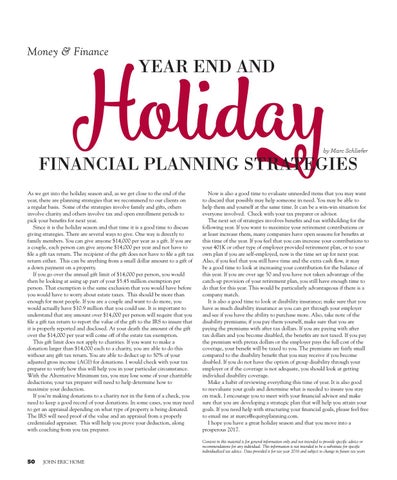Money & Finance
Holiday YEAR END AND
by Marc Schliefer
FINANCIAL PLANNING STRATEGIES As we get into the holiday season and, as we get close to the end of the year, there are planning strategies that we recommend to our clients on a regular basis. Some of the strategies involve family and gifts, others involve charity and others involve tax and open enrollment periods to pick your benefits for next year. Since it is the holiday season and that time it is a good time to discuss giving strategies. There are several ways to give. One way is directly to family members. You can give anyone $14,000 per year as a gift. If you are a couple, each person can give anyone $14,000 per year and not have to file a gift tax return. The recipient of the gift does not have to file a gift tax return either. This can be anything from a small dollar amount to a gift of a down payment on a property. If you go over the annual gift limit of $14,000 per person, you would then be looking at using up part of your $5.45 million exemption per person. That exemption is the same exclusion that you would have before you would have to worry about estate taxes. This should be more than enough for most people. If you are a couple and want to do more, you would actually have $10.9 million that you could use. It is important to understand that any amount over $14,000 per person will require that you file a gift tax return to report the value of the gift to the IRS to insure that it is properly reported and disclosed. At your death the amount of the gift over the $14,000 per year will come off of the estate tax exemption. This gift limit does not apply to charities. If you want to make a donation larger than $14,000 each to a charity, you are able to do this without any gift tax return. You are able to deduct up to 50% of your adjusted gross income (AGI) for donations. I would check with your tax preparer to verify how this will help you in your particular circumstance. With the Alternative Minimum tax, you may lose some of your charitable deductions; your tax preparer will need to help determine how to maximize your deduction. If you’re making donations to a charity not in the form of a check, you need to keep a good record of your donations. In some cases, you may need to get an appraisal depending on what type of property is being donated. The IRS will need proof of the value and an appraisal from a properly credentialed appraiser. This will help you prove your deduction, along with coaching from you tax preparer.
Now is also a good time to evaluate unneeded items that you may want to discard that possibly may help someone in need. You may be able to help them and yourself at the same time. It can be a win-win situation for everyone involved. Check with your tax preparer or advisor. The next set of strategies involves benefits and tax withholding for the following year. If you want to maximize your retirement contributions or at least increase them, many companies have open seasons for benefits at this time of the year. If you feel that you can increase your contributions to your 401K or other type of employer provided retirement plan, or to your own plan if you are self-employed, now is the time set up for next year. Also, if you feel that you still have time and the extra cash flow, it may be a good time to look at increasing your contribution for the balance of this year. If you are over age 50 and you have not taken advantage of the catch-up provision of your retirement plan, you still have enough time to do that for this year. This would be particularly advantageous if there is a company match. It is also a good time to look at disability insurance; make sure that you have as much disability insurance as you can get through your employer and see if you have the ability to purchase more. Also, take note of the disability premiums; if you pay them yourself, make sure that you are paying the premiums with after tax dollars. If you are paying with after tax dollars and you become disabled, the benefits are not taxed. If you pay the premium with pretax dollars or the employer pays the full cost of the coverage, your benefit will be taxed to you. The premiums are fairly small compared to the disability benefit that you may receive if you become disabled. If you do not have the option of group disability through your employer or if the coverage is not adequate, you should look at getting individual disability coverage. Make a habit of reviewing everything this time of year. It is also good to reevaluate your goals and determine what is needed to insure you stay on track. I encourage you to meet with your financial advisor and make sure that you are developing a strategic plan that will help you attain your goals. If you need help with structuring your financial goals, please feel free to email me at marcs@equityplanning.com. I hope you have a great holiday season and that you move into a prosperous 2017. Content in this material is for general information only and not intended to provide specific advice or recommendations for any individual. This information is not intended to be a substitute for specific individualized tax advice. Data provided is for tax year 2016 and subject to change in future tax years
50
JOHN ERIC HOME
